| 1 |
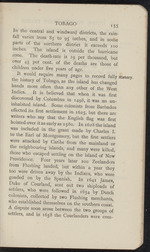 |
“...say that the English flag was first
hoisted over it as early as 1580. In 1628 the island
was included in the grant made by Charles I.
to the Earl of Montgomery, but the first settlers
were attacked by Caribs from the mainland or
the neighbouring islands, and many were killed
those who escaped settling on the island of New
Providence. Four years later 200 Zeelanders
rom Flushing landed, but within a year they
too were driven away by the Indians, who were
goaded on by the Spanish. In 1641 James,
Duke of Courland, sent out two shiploads of
settlers, who were followed in 1654 by Dutch
colonists collected by two Flushing merchants,
who established themselves on the southern coast.
A dispute soon arose between the two groups of
settlers, and in 1658 the Courlanders were com-...”
|
|
| 2 |
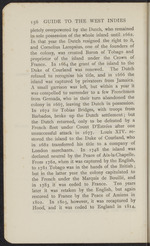 |
“...Dutch resigned the right to it,
and Cornelius Lampsius, one of the founders of
the colony, was created Baron of Tobago and
proprietor of the island under the Crown of
France. In 1664 the grant of the island to the
Duke of Courland was renewed. The Dutch
refused to recognise his title, and in 1666 the
island was captured by privateers from Jamaica.
A small garrison was left, but within a year it
was compelled to surrender to a few Frenchmen
from Grenada, who in their turn abandoned the
colony in 1667, leaving the Dutch in possession.
In 1672 Sir Tobias Bridges, with troops from
Barbados, broke up the Dutch settlement; but
the Dutch returned, only to be defeated by a
French fleet under Count D’Estrées after one
unsuccessful attack in 1677. Louis XIV. re-
stored the island to the Duke of Courland, who
in 1682 transferred his title to a company of
London merchants. In 1748 the island was
declared neutral by the Peace of Aix-la-Chapelle.
From 1762, when it was captured by the English,
to 1781 Tobago...”
|
|
| 3 |
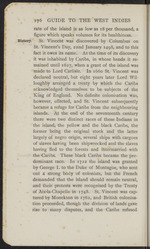 |
“...a refuge for Caribs from the neighbouring
islands. At the end of the seventeenth century
there were two distinct races of these Indians in
the island, the yellow and the black Caribs, the
former being the original stock and the latter
largely of negro origin, several ships with cargoes
of slaves having been shipwrecked and the slaves
having fled to the forests and intermarried with
the Caribs. These black Caribs became the pre-
dominant race. In 1722 the island was granted
by George I. to the Duke of Montague, who sent
out a strong body of colonists, but the French
demanded that the island should remain neutral,
and their protests were recognised by the Treaty
of Aix-la-Chapelle in 1748. St. Vincent was cap-
tured by Monckton in 1762, and British colonisa-
tion proceeded, though the division of lands gave
rise to many disputes, and the Caribs refused...”
|
|
| 4 |
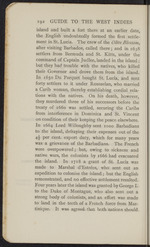 |
“...Barbadians
to the island, defraying their expenses out of the
4h Per cent, export duty, which for many years
was a grievance of the Barbadians. The French
were overpowered; but, owing to sickness and
native wars, the colonists by 1666 had evacuated
the island. In 1718 a grant of St. Lucia was
made to Marshal d’Estrées, who sent out an
expedition to colonise the island; but the English
remonstrated, and no effective settlement resulted..
Four years later the island was granted by George L
to the Duke of Montague, who also sent out a
strong body of colonists, and an effort was made
to land in the teeth of a French force from Mar-
tinique. It was- agreed, that hath nations should-....”
|
|
| 5 |
 |
“...from Gros
Islet Bay, at the north-east of the island, that
Rodney sailed with his fleet and inflicted a deci-
sive defeat on Count de Grasse between Dominica
and Guadeloupe on the memorable 12th April
1782. St. Lucia was restored to the French by
the Treaty of Versailles, which followed. During
the French Revolution the Maroon negroes gave
great trouble, and in 1794 Admiral Jervis, after-
wards Lord St. Vincent, took St. Lucia, the Morne
Fortunée being captured on 4th April in that year
by the Duke of Kent, the father of Queen Victoria,
but it was recovered by Victor Hugues, the French
republican, who was a friend of Robespierre, in
1795. Abercromby and Sir John Moore were
sent out to subdue St. Lucia, and though the
N...”
|
|
| 6 |
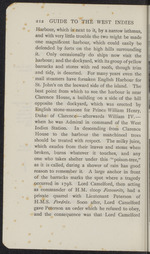 |
“....hills surrounding
it. Only occasionally do ships now visit the
harbour; and the dockyard, with its group of yellow
barracks and stores with red roofs, though trim
and tidy, is deserted. For many years even the
mail steamers have forsaken English Harbour for
St. John’s on the leeward side of the island. The
best point from which to see the harbour is near
Clarence House, a building on a side of the hill
opposite the dockyard, which was erected by
English stone-masons for Prince William Henry,
Duke of Clarence—afterwards William IV.______
when he was Admiral in command of the West
Indies Station. In descending from Clarence
House to the harbour the manchineel trees
should be treated with respect. The milky juice,
which exudes from their leaves and stems when
broken, burns whatever it touches, and any
one who takes shelter under this “poison-tree,” j
as it is called, during a shower of rain has good
reason to remember it A large anchor in front
of the barracks marks the spot where a tragedy...”
|
|
| 7 |
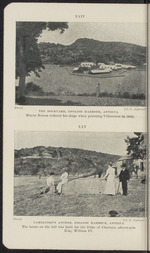 |
“...XXIV
_
WmÊ
W&sm
Wmmm
Photo] [A..E. Aspinalï
THE DOCKYARD, ENGLISH HARBOUR, ANTIGUA
Where Nelson refitted his ships when pursuing Villeneuve in 1£££.
XXV
paLyt
WÉÊÈSÊÊÊt
mmm
phot°\ [A.E.Aspinatm
CAMELFORD S ANCHOR, ENGLISH HARBOUR, ANTIGUA
The house on the hill was built for the Duke of Clarence, afterwards
King William IV....”
|
|
| 8 |
 |
“...Church, where the Register containing
Church. tjje entry 0f the certificate of Nelson’s marriage
to Mrs. Nisbet, a resident of Nevis, is kept,
is ij miles from Charlestown. The entry of
the marriage certificate, which runs: “1787,
March nth, Horatio Nelson, Esquire, Captain of
His Majesty’s ship the Boreas, to Frances Herbert
Nisbet, widow,” is shown to visitors. At the time
of her wedding the bride was in her twenty-third
year, and her late husband, a doctor, had been dead
for eighteen months. The Duke of Clarence,
afterwards King William IV., was best man at the
wedding. The ruins of Montpelier, where the
ceremony was performed, are also pointed out.
The view from the church, over a wide expanse of
sea, the town, and the whole length of St Kitts
with St. Eustatius beyond, is very beautiful. A
Round the drive round the island is to be recommended. The
island» ^stance is 2o miles, and the time required from
three to four hours. The road is excellent, and
the views obtained en route surpassingly...”
|
|
| 9 |
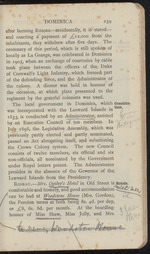 |
“...DOMINICA
239
after burning Roseau—accidentally, it is stated
and exacting a payment of ^12,000 from the
inhabitants, they withdrew after five days. The
centenary of this period, which is still spoken of
locally as La Grange, was celebrated in Dominica
in 1905, when an exchange of courtesies by cable
took place between the officers of the, Duke
of Cornwall’s Light Infantry, which formed part
of the defending force, and the Administrator of
the colony. A dinner was held in honour of
the occasion, at which plate presented to the
regiment by the grateful colonists was used.
The local government in Dominica, which Constitu-
was incorporated with the Leeward Islands in }
1833, is conducted by an Administrator, assisted
by an Executive Council of ten members. In . ƒ, 1
July 1898, the Legislative Assembly, which was
previously partly elected and partly nominated,
passed an Act abrogating itself, and substituting
the Crown Colony system. The new Council
consists of twelve members, six official and...”
|
|
| 10 |
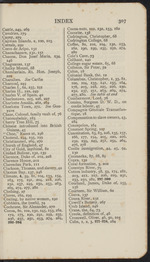 |
“...Chamberlain, Rt. Hon. Joseph,
222
Charaibes. See Caribs
Charcoal, 249
Charles I., 61, 155, 19.1
Charles II., 122, 249
Charles V. of Spain, 42
Charlestown, 225, 226, 227
Charlotte Amalia, 262, 264
Charlotte Town, 171. See Gou-
yave
Chase, Colonel, family vault of, 76
Chateaubelair, 185
Cherry Tree Hill, 75
Chinese introduced into British
Guiana, 45
“ Choc," Races at, 196
Choiseul, 194, 195, 199
Christiansted, 269, 270
Church of England, 47
City of Gold, mythical, 82
Ciudad Bolivar, 132, 139
Clarence, Duke of, 212, 228
Clarence House, 212
Clarendon Park, in
Clarkson, Thomas, and slavery, 42
Claxton Bay, 137, 146
Climate, 4, 59, 81, 104, 133, 154,
163, 175. I91» 204, 218, 226,
232. 237, 249, 250, 253, 263,
269, 274, 277, 280
Clothing, 27
Cloves, 162, 199
‘Coaling, by native women, 190
Cobblers, the (reefs), 74
Cochrane, Sir Alexander, 270
Cocoa, 80, 102,132,145,153,162,
172, 175, 190, 191, 199, 235,
236, 237, 250, 253, 274, 284,
292-294
307
Cocoa-nuts, 102,132,153, 162
Cocorite, 138
Codrington, ...”
|
|
| 11 |
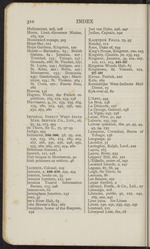 |
“...250,
253, 262, 269, 271, 274, 280
Infectious diseases, 6
Ipswich, in, 128
Irish brogue in Montserrat, 50
Irish prisoners as settlers, 46
Jackson, Colonel, 105
Jamaica, 2, 100-199, 292, 294
Jamaica, books on, 53
Jamaica Institute, 117, 120
Jamaica Tourist Information
Bureau, 115, 128
Jamestown, 61
Jerningham Junction, 137
Jews, 47
Joe's River Halt, 65
John Brewer’s Bay, 267
Josephine, home of the Empress,
252
Jost van Dyke, 246, 247
Judlee, Captain, 192
Kaieteur Falls, 79, 95
Kendal, 111
Kent, Duke of, 193
King’s House, Kingston, 120,123
Kingsley, Charles, 70, 135,143
Kingston, Jamaica, 34, 101, 107, ]
no, in, 114, 115-117
Kingston Woods Halt, 65
Kingstown, St. Vincent, 174, 1
177-187
Kir van, Patrick, 210
Kola, 162
Koninklijke West-Indische Mail j
Dienst, 19
Kyk-over-al, 82
L’Abys, 243
La Brea, 148
La Désirade, 251
La Grange, General, 238
La Vigée, 197, 198
Labat, Père, 51, 241
Laborie, 195, 199
Labour question, the, 41, 43, 44, 1
45.94.130
Lampsius, Cornelius, Baron of I
Tobago, 156
Language...”
|
|
| 12 |
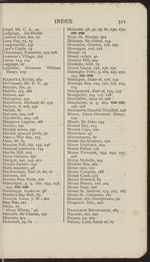 |
“..., 3, 5, 182, 234, 238,
241, 252-260
Martinique, books on, 56
Martin’s Bay Halt, 65
Maurice, Lieut. J. W., 201
May Pen, 111
Meals, 10
" Mean Whites,” 46
Metcalfe, Sir Charles, 127
Minerals, 274
Molascuit, 79, 81
311
Molasses, 58, 59, 79, 81,132, 174,
287-290
Mole, St. Nicolas, 274
Moloney, Sir Alfred, 144
Monckton, General, 176, 193
Moneague, 108, 128
Money, 12
Money orders, 40
Monkey Hill, 224
Monkeys, wild, 75
Monos Island, 131, 136, 151
Montagne Pelée, 5,182, 245,252,
253, 255-260
Montague, Duke of, 176, 192
Montego Bay, 109, no, in, 113,
114
Montgomery, Earl of, 134, 155
Montpelier, 109, in, 128
Montpelier, ruins of, 228
Montserrat, 2, 5, 203, 230-233,
236, 298
Montserrat District, Trinidad, 146
Moore, Lieut.-Governor Henry,
123
Moore, Sir John, 193
Morant Bay, 113
Morant Cays, 100
Moravians, 47
Morawhanna, 87
Morne des Sauteurs, 172
Morne Diablotin, 234
Morne Fédon, 171
Morne Fortunée, 193, 194, 197,
198
Morne Nicholls, 244
Moskito Bay, 267
Motor cars, no
Mount Canaries, 188
Mount Conil...”
|
|
